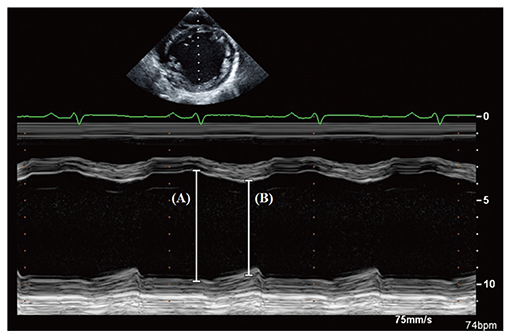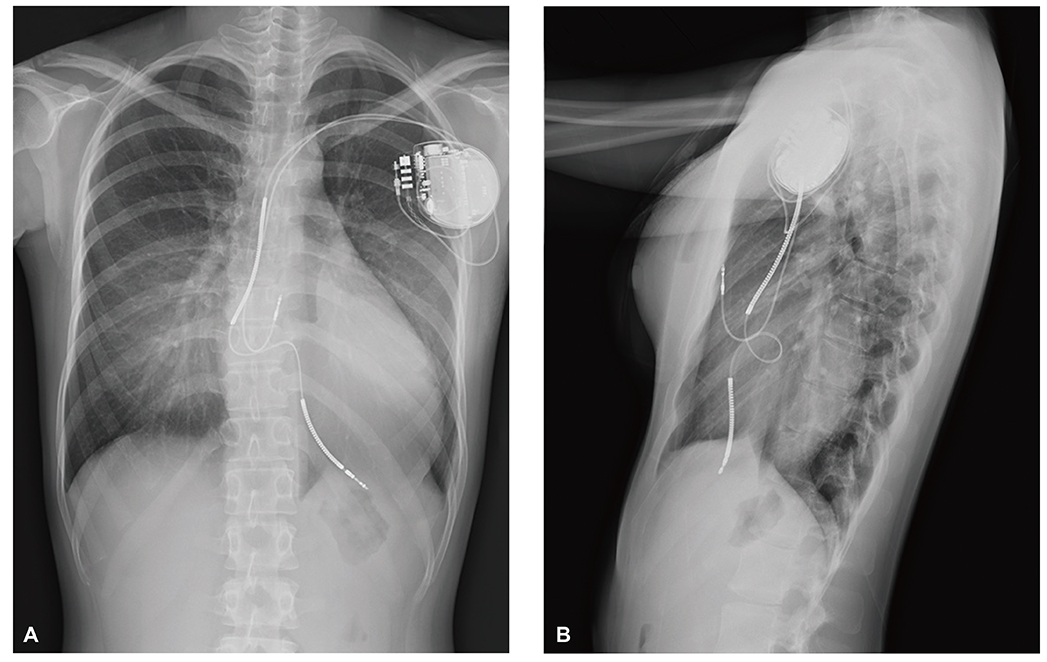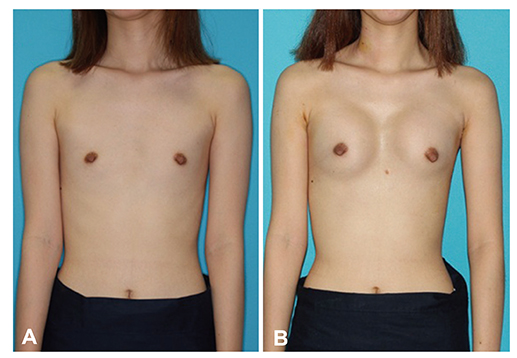Korean Circ J.
2016 Sep;46(5):734-738. 10.4070/kcj.2016.46.5.734.
Combined Subpectoral Implantation of Implantable Cardioverter-Defibrillator and Augmentation Mammoplasty in a Young Female Patient
- Affiliations
-
- 1Department of Cardiology, Severance Hospital, Yonsei University College of Medicine, Seoul, Korea. jason@yuhs.ac
- 2Department of Plastic and Reconstruction Surgery, Severance Hospital, Yonsei University College of Medicine, Seoul, Korea.
- 3Department of Anesthesiology and Pain Medicine, Severance Hospital, Yonsei University College of Medicine, Seoul, Korea.
- KMID: 2389634
- DOI: http://doi.org/10.4070/kcj.2016.46.5.734
Abstract
- Subcutaneous implantation of a cardiac implantable electronic device is the standard method. Occasionally, subpectoral cardiac implantable electronic device (CIED) implantation via axillary incisions is performed in young female patients for cosmetic purposes. Because subpectoral CIED implantation and augmentation mammoplasty involve the same layer, it is feasible to perform both procedures simultaneously. We report a case of combined subpectoral implantation of an implantable cardioverter-defibrillator and augmentation mammoplasty via the axillary approach in a young female patient with dilated cardiomyopathy and small breasts.
Keyword
MeSH Terms
Figure
Reference
-
1. Moss AJ, Zareba W, Hall WJ, et al. Prophylactic implantation of a defibrillator in patients with myocardial infarction and reduced ejection fraction. N Engl J Med. 2002; 346:877–883.2. Goldberger Z, Lampert R. Implantable cardioverter-defibrillators: expanding indications and technologies. JAMA. 2006; 295:809–818.3. Mond HG, Proclemer A. The 11th world survey of cardiac pacing and implantable cardioverter-defibrillators: calendar year 2009--a World Society of Arrhythmia's project. Pacing Clin Electrophysiol. 2011; 34:1013–1027.4. Burns KM, Evans F, Kaltman JR. Pediatric ICD utilization in the United States from 1997 to 2006. Heart Rhythm. 2011; 8:23–28.5. Starrenburg A, Pedersen S, van den Broek K, Kraaier K, Scholten M, Van der Palen J. Gender differences in psychological distress and quality of life in patients with an ICD 1-year postimplant. Pacing Clin Electrophysiol. 2014; 37:843–852.6. Vazquez LD, Kuhl EA, Shea JB, et al. Age-specific differences in women with implantable cardioverter defibrillators: an international multi center study. Pacing Clin Electrophysiol. 2008; 31:1528–1534.7. Kistler PM, Fynn SP, Mond HG, Eizenberg N. The subpectoral pacemaker implant: it isn't what it seems! Pacing Clin Electrophysiol. 2004; 27:361–364.8. Reiffel JA, Dizon J. Cardiology patient page. The implantable cardioverter-defibrillator: patient perspective. Circulation. 2002; 105:1022–1024.9. Giudici MC, Carlson JI, Krupa RK, Meierbachtol CJ, Vanwhy KJ. Submammary pacemakers and ICDs in women: long-term follow-up and patient satisfaction. Pacing Clin Electrophysiol. 2010; 33:1373–1375.10. Obeyesekere MN, Kamberi S, Youngs N, Alison J. Long-term performance of submammary defibrillator system. Europace. 2010; 12:1239–1244.11. Gold MR, Peters RW, Johnson JW, Shorofsky SR. Complications associated with pectoral cardioverter-defibrillator implantation: comparison of subcutaneous and submuscular approaches. Worldwide Jewel Investigators. J Am Coll Cardiol. 1996; 28:1278–1282.12. Thomas DE, Murison MS, Anderson MH. Combined subpectoral implantation of a cardioverter defibrillator and breast augmentation surgery in a patient with Emery-Dreifuss muscular dystrophy. Future Cardiol. 2015; 11:293–295.13. Al-Bataineh M, Sajadi S, Fontaine JM, Kutalek S. Axillary subpectoral approach for pacemaker or defibrillator implantation in patients with ipsilateral prepectoral infection and limited venous access. J Interv Card Electrophysiol. 2010; 27:137–142.
- Full Text Links
- Actions
-
Cited
- CITED
-
- Close
- Share
- Similar articles
-
- Transvenous Implantation of an Implantable Cardioverter Defibrillator in a Patient Who Had Undergone Tricuspid Valve Replacement
- Endoscopically Assisted Transumbilical Subpectoral Augmentation Mammoplasty
- Implantable Cardioverter-Defibrillator (ICD) Therapy: Initial Clinical Experience in 6 Patients
- A Case Report of the Patient Implanted with Automatic Implantable Cardioverter Defibrillator (AICD) Subject to 3rd Molar Extraction using Target Controlled Infusion of Propofol and Remifentanil: A Case Report
- Delayed Perforation of the Right Ventricular Wall by a Single Standard-Caliber Implantable Cardioverter-Defibrillator Lead Detected by Multidetector Computed Tomography







